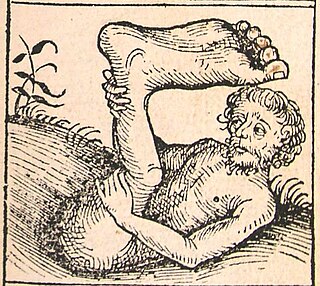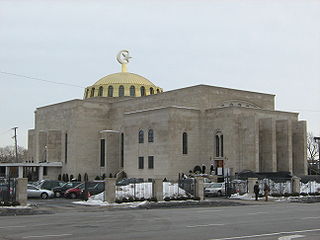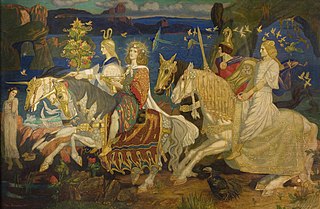 W
WAbarimon or antipode in mythology are people whose feet are turned backwards, but in spite of this handicap were able to run at great speed.
 W
WAntichthones, in geography, are those peoples who inhabit the antipodes, regions on opposite sides of the Earth. The word is compounded of the Greek ὰντὶ ("opposed") and χθών ("earth").
 W
WIn medieval Irish myth, the Fir Bolg are the fourth group of people to settle in Ireland. They are descended from the Muintir Nemid, an earlier group who abandoned Ireland and went to different parts of Europe. Those who went to Greece became the Fir Bolg and eventually return to Ireland, after it had been uninhabited for many years. After ruling it for some time and dividing the island into provinces, they are overthrown by the invading Tuatha Dé Danann.
 W
WVarious species of mythical headless men were rumoured, in antiquity and later, to inhabit remote parts of the world. They are variously known as akephaloi or Blemmyes and described as lacking a head, with their facial features on their chest. These were at first described as inhabitants of ancient Libya or the Nile system (Aethiopia). Later traditions confined their habitat to a particular island in the Brisone River, or shifted it to India.
 W
WIn the Lebor Gabála Érenn, a medieval Irish Christian pseudo-history, the Milesians are the final race to settle in Ireland. They represent the Irish people. The Milesians are Gaels who sail to Ireland from Iberia (Hispania) after spending hundreds of years travelling the earth. When they land in Ireland they contend with the Tuatha Dé Danann, who represent the pagan gods. The two groups agree to divide Ireland between them: the Milesians take the world above, while the Tuath Dé take the world below.
 W
WMonopods are mythological dwarf-like creatures with a single, large foot extending from a leg centered in the middle of their bodies. The names monopod and skiapod (σκιάποδες) are both Greek, respectively meaning "one-foot" and "shadow-foot".
 W
WThe moon-eyed people are a legendary group of people who are said to have lived in Appalachia until the Cherokee expelled them. Stories about them, attributed to Cherokee tradition, are mentioned by early European settlers in America. In a 1797 book, Benjamin Smith Barton explains they are called "moon-eyed" because they saw poorly during the day. Later stories about the people add additional details, saying that they had white skin, they created the area's pre-Columbian ruins, and they disappeared from the area. Barton cited as his source a conversation with Colonel Leonard Marbury, an early settler of Georgia. Marbury, a Revolutionary War officer and a Congressman in the Second Provincial Congress of Georgia (1775), acted as intermediary between Native American Indians in the state of Georgia and the United States government.
 W
WNemed or Nimeth is a character in medieval Irish legend. According to the Lebor Gabála Érenn, he was the leader of the third group of people to settle in Ireland: the Muintir Nemid, Clann Nemid or "Nemedians". They arrived thirty years after the Muintir Partholóin, their predecessors, had died out. Nemed eventually dies of plague and his people are oppressed by the Fomorians. They rise up against the Fomorians, attacking their tower out at sea, but most are killed and the survivors leave Ireland. Their descendants become the Fir Bolg and the Tuatha Dé Danann.
 W
WThe Patagones or Patagonian giants were a race of giant humans rumoured to be living in Patagonia and described in early European accounts and indigenous myths. They were said to have exceeded at least double normal human height, with some accounts giving heights of 12 to 15 feet or more. Tales of these people would maintain a hold upon European conceptions of the region for some 250 years.
 W
WThe Red Jews, a legendary Jewish nation, appear in vernacular sources in Germany during the medieval era, from the 13th to the 15th centuries. These texts portray the Red Jews as an epochal threat to Christendom, one which would invade Europe during the tribulations leading to the end of the world.
 W
WRoot races are stages in human evolution in the esoteric cosmology of theosophist Helena Petrovna Blavatsky, as described in her book The Secret Doctrine (1888). These races existed mainly on now-lost continents. Blavatsky's model was developed by later theosophists, most notably William Scott-Elliot in The Story of Atlantis (1896) and The Lost Lemuria (1904). Annie Besant further developed the model in Man: Whence, How and Whither (1913). Both Besant and Scott-Elliot relied on information from Charles Webster Leadbeater obtained by "astral clairvoyance". Further elaboration was provided by Rudolf Steiner in Atlantis and Lemuria (1904). Rudolf Steiner, and subsequent theosophist authors, have called the time periods associated with these races Epochs.
 W
WThe Tribe of Shabazz was, according to the Nation of Islam, a supposed ancient Black nation that migrated into central Africa, led by a leader named Shabazz. The concept is found primarily in the writings of Wallace Fard Muhammad and Elijah Muhammad. According to the Autobiography of Malcolm X, all the races except the white race were descendants of the Tribe of Shabazz.
 W
WThe Tuath(a) Dé Danann, also known by the earlier name Tuath Dé, are a supernatural race in Irish mythology. They are thought to represent the main deities of pre-Christian Gaelic Ireland. The Tuatha Dé Danann constitute a pantheon whose attributes appeared in a number of forms throughout the Celtic world.